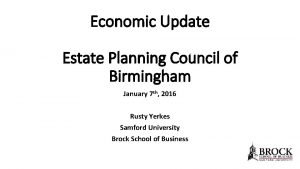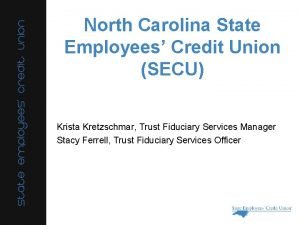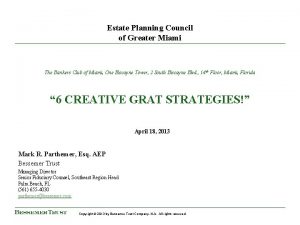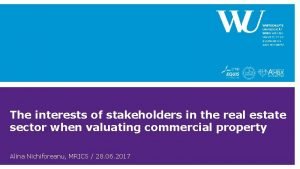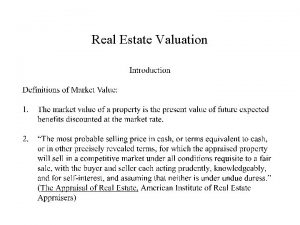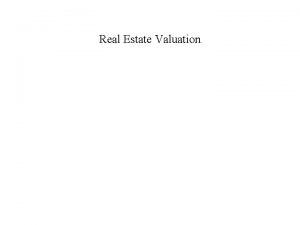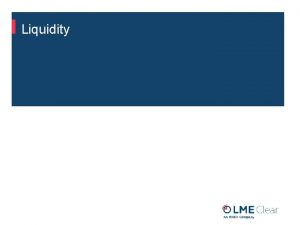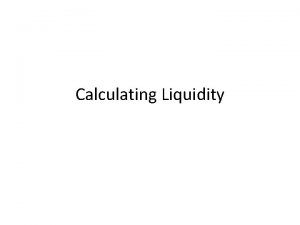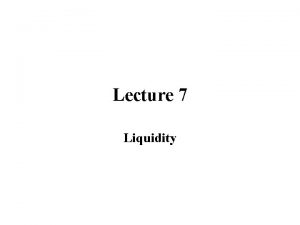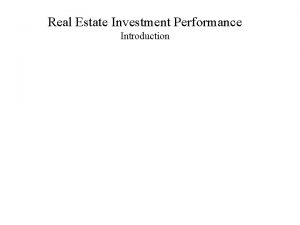School of Real Estate Planning Liquidity Pricing in



















- Slides: 19

School of Real Estate & Planning Liquidity Pricing in Unlisted Real Estate Funds Giovanni Tira and Gianluca Marcato © Henley Business School 2008 www. henley. reading. ac. uk

Agenda • Introduction and Results Overview • Data Description • Model and variables • Liquidity pricing • Conclusions School of Real Estate & Planning 2

Liquidity: Volumes • Total return index falling from 08 • Positive relationship • Liquidity leading returns • Unit and NAV are similar • Percentage of outstanding has volatile behaviour School of Real Estate & Planning 3

Return, manager and style Style Return Manager Style Source: INREV School of Real Estate & Planning 4

Research Questions • What are the risk driving factors for open ended unlisted fund? • How can we define liquidity? • Are returns and liquidity auto-correlated? • What is the causality between liquidity and returns? • Do manager’s characteristics and investor type bring better performances? School of Real Estate & Planning 5

Results Overview • Volumes do not provide any pricing signal, while outflows and net flows do • Volumes do not suggest return chasing behaviour, while inflows and net flows do • Other fund characteristics have consistent effect in several models • Manager’s characteristics do not seem to play an important role • Using these results within an investment strategy helps to improve the performance of a fund of funds School of Real Estate & Planning 6

Literature Review • Pricing signal in real estate markets: – Movements of liquidity in REITs influence fund returns: Chui, Titman and Webb (2000) – Reaction to fund liquidity shocks: Ooi, Ong and Li (2008) – Common factors and different timing of liquidity effects on REITs and REMFs: Tuluca, Myer and Webb (2000) – Private real estate market turnover has a price pressure effect on returns: Ling, Marcato and Mc. Allister (2009) • Return chasing behaviour in real estate markets – REIT and mutual funds: Ling and Naranjo (2003, 2006) – Private real estate markets: Ling, Marcato and Mc. Allister (2009) School of Real Estate & Planning 7

Literature Review • Liquidity and total return in equity markets – Away from optimal allocation (cash issue): Edelen (1998) – Return chasing behaviour / money smart effect • Redeem (invest in) -ve (+ve) past returns: Ivkovic and Weisbenner (2008) • After-tax returns influence net fund flows: Poterba (2001) • Studies on Real Estate Mutual Funds (REMFs): – Active REMFs beat passive funds: O’neal and Page (2000) – Stock market performance influences REMF returns: Gullet and Redman (2005) – Rising equity markets lead to an increase in redemptions and affect total returns: Brounen et al. (2007) – REMFs are driven by the same sentiment driving the stock market: Tomperi (2009) School of Real Estate & Planning 8

Data Description • Source: IPD property fund vision • 84 UK Real estate mutual fund – 71 open ended funds (Specialised 31, Diversified 40) – 13 closed ended funds • Sample period: 1 Q 2005 – 1 Q 2009 – 1100 quarterly observations • Outstanding value: £ 50 billion – 53% of UK market, 20% European market • Source for other variables: Thomson Data. Stream School of Real Estate & Planning 9

How to Proxy Liquidity • Three definitions of liquidity: – Volumes – Inflows and outflows – Net flows • Three definitions of flows: Types of Liquidity – Number of units – Net Asset Value (i. e. NAV) – Percentage (%age) of total amount School of Real Estate & Planning Types of flows # Units NAV %age Volumes 1 2 3 In/Outflows 4 5 6 Net flows 7 8 9 10

Summary Statistics School of Real Estate & Planning 11

Sample Analysis Total return and volatility • REMFs lag equity return by one quarter in the first part of the sample and are less volatile • Increasing volatility after Real Estate bubble • UK valuers have considered market sentiment School of Real Estate & Planning 12

Vector Auto. Regressive (VAR) Model • Uncertainty about causality (i. e. endogeneity) : – VAR model with 4 lags (1 year) for liquidity – Lag of 1 period for other variables • Joint effect of lags: Wald Test • Effect of manager on return: manager related variables School of Real Estate & Planning 13

Model and Variables are divided following an idea of Ghosh and Sirmans (2005): • • • Endogenous Exogenous Fund size Debt Specialization Asset turnover Vintage • Stock market returns • Grow in GDP School of Real Estate & Planning Investor • Flows • Redemptions outstanding 14

Results: Liquidity Trading Pricing signal School of Real Estate & Planning Return chasing behaviour 15

Results: Total Return (Volumes) • The dimension of the fund implies managerial difficulties rather than economies of scales Total Return Liquidity • Turnover of assets does not grant any extra returns • The higher the leverage, the higher the absolute return. . . Hence negative impact in late 2000 s • Cash is seen as a valuable option to acquire investments with positive NPV (prevailing effect on lost returns) • Asset concentration does not improve returns. • Equity markets are positively related to REMFs • Surprisingly better GDP growth reduces returns in REMFs • Outstanding redemptions represent a risk which is priced School of Real Estate & Planning 16

Results: asset manager related variables • Opportunistic funds are the only ones to show both different – Performance (higher in absolute term) and – Liquidity (higher than core and value added) School of Real Estate & Planning 17

Conclusions • Liquidity effect on total return: – Volumes do not contain any pricing information, but outflows and net flows do – Better performing funds attract more capital (i. e. return chasing behaviour for inflows and net flows) • Exogenous and endogenous variable have consistent effect throughout different models • Manager’s characteristics do not seem to provide outperformance, but single managers may still do. School of Real Estate & Planning 18

Thank you for your attention Any questions? School of Real Estate & Planning 19
 Strategic planning real estate
Strategic planning real estate Real homes real estate
Real homes real estate Liquidity planning and managing cash assets
Liquidity planning and managing cash assets Colliers turley martin tucker
Colliers turley martin tucker Estate planning council of birmingham
Estate planning council of birmingham Keogh plan definition
Keogh plan definition Intentionally defective grantor trust
Intentionally defective grantor trust Montgomery county estate planning council
Montgomery county estate planning council Omaha estate planning council
Omaha estate planning council Estate planning palos verdes peninsula
Estate planning palos verdes peninsula Secu estate planning
Secu estate planning Chicago estate planning council
Chicago estate planning council Transamerica estate planning foreign nationals
Transamerica estate planning foreign nationals Estate planning council of greater miami
Estate planning council of greater miami Ministry estate planning
Ministry estate planning 60 second pitch
60 second pitch Kwueval
Kwueval Real estate stakeholders
Real estate stakeholders Greece property market
Greece property market Sandy miller real estate
Sandy miller real estate




